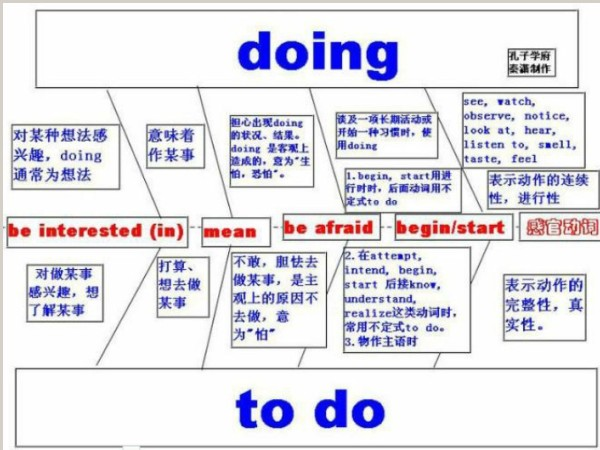本试题 “There's no doubt _____ international cooperation is the key to _____ with cybercrime. (网络犯罪)A. whether; doingB. that; dealingC. whether; doD. t...” 主要考查您对动名词
同位语从句
等考点的理解。关于这些考点您可以点击下面的选项卡查看详细档案。
- 动名词
- 同位语从句
动名词概念:
动名词是一种兼有动词和名词特征的非限定动词。它可以支配宾语,也能被副词修饰,动名词有时态和语态的变化。
现在分词和动名词用法比较:
动词的-ing形式包括现在分词和动名词两种形式。他们的句法功能如下:
动词的-ing形式如果作句子的主语或者宾语时,应该是动名词形式;如果作补语或者状语时,应该是现在分词形式。那么作表语或者定语的动名词和现在分词又该怎样区分呢?
1、动名词与现在分词作表语时的比较:
(1)动名词作表语说明主语的内容,回答what的问题;现在分词作表语相当于形容词作表语,说明主语的性质、特征等,回答how的问题。
如:One of the best exercises is swimming. 游泳是最好的运动项目之一。
What pleases him most is bathing in the sea. 最使他高兴的事是在海中沐浴。
The situation both at home and abroad is very in-spiring. 国内外的形势都很鼓舞人心。
The color is pleasing to the eye. 颜色悦目。
(2)动名词作表语,表语和主语几乎处于同等地位,可以互换位置,其句意不变;现在分词作表语,表语和主语则不能互换位置。
如:Our work is serving the people.
(=Serving the people is our work.)我们的工作是为人民服务。
The news was disappointing. 那消息令人失望。
(3)作表语的现在分词前可以用very,quite,rather,greatly等副词修饰,而动名词则不可以。
如:What he said was very encouraging. 他的话很鼓舞人心。
Our goal is realizing the four modernizations in the near future. 我们的目标是在不久的将来实现四个现代化。
(4)现在分词与形容词一样可以和more,the most构成形容词的比较级和最高级,而动名词则不可以。
如:The story is the most fascinating. 那个故事最迷人。
(5)作表语用的现在分词除了和be连用以外,还可以和其它的系动词连用;而作表语的动名词则通常只能和be连用。
如:His speech seems inspiring.他的演讲似乎很鼓舞人心。
His interest is writing for the news papers. 他的爱好是给报社写文章。
(6)有些用作表语的现在分词已经形容词化了。常见的有:exciting,moving,inspiring,missing,interesting,disappointing等。
2、动名词与现在分词作定语时的比较:
(1)动名词作定语时,表示它所修饰的名词的性能和用途,和它所修饰的名词在逻辑上没有主谓关系;
现在分词作定语时,表示它所修饰的名词正在进行的动作,和它所修饰的名词在逻辑上有主谓关系,常可以扩展成一个定语从句。
如:a swimming girl=a girl who is swimming 一个在游泳的姑娘
a walking stick=a stick that is used for walking 一根拐杖
(2)现在分词作定语有时可以后置,而动名词则通常只能放在它所修饰的名词之前。
如:The girl wearing glasses is one of his students. 戴眼镜的那个女孩是他的一个学生。
I bought some reading materials. 我买了一些阅读材料。
动名词的用法:
1、作主语:
例如:Fighting broke out between the South and the North. 南方与北方开战了。
2、作宾语:
a. 有些动词可以用动名词作宾语。
例如:admit承认 appreciate感激 avoid避免 complete完成 consider认为 delay耽误 deny否认 detest讨厌 endure忍受 enjoy喜欢 escape逃脱 fancy想象 finish完成 imagine想象 mind介意 miss想念 postpone推迟 practice训练 recall回忆 resent讨厌 resume继续 resist抵抗 risk冒险 suggest建议 face面对 include包括 stand忍受 understand理解 forgive宽恕 keep继续
例如:Would you mind turning down your radio a little, please? 你把收音机音量调小一点,好吗?
The squirrel was lucky that it just missed being caught. 这松鼠幸运得很,刚逃避了被逮住的厄运。
b. 有些结构后面可以用动名词作宾语或其他成分。
例如:admit to prefer...to burst out keep on insist on count on set about put off be good at take up give up be successful in be used to lead to devote oneself to object to stick to no good no use be fond of look forward to be proud of be busy can't help be tired of be capable of be afraid of think of
3、作表语,对主语说明、解释:
例如:Her job is washing, cleaning and taking care of the children. 她的工作是洗刷、清扫和照顾孩子。
比较:She is washing, cleaning and taking care of the children.
4、作定语,一般表示所修饰名词事物的用途:
例如:a writing desk=a desk for writing 写字台
a swimming pool=a pool swimming 游泳池
有些动名词作定语,与所修饰的名词关系比较复杂。
例如:boiling point=a temperature point at which something begins to boil 沸点
a walking tractor=a tractor which a driver can operate while he or she is walking behind it 手扶拖拉机
动名词知识体系:

动名词与不定式用法对比:

同位语从句的概念:
在复合句中充当同位语的名词性从句称为同位语从句。同位语从句是名词性从句(主语从句、表语从句、宾语从句、同位语从句)中的主要从句之一,从句作同位语表示与之同位的名词(短语)的实际内容,它的作用相当于名词,对前面的名词(短语)加以补充说明或进一步解释,相当于一个表语从句,它们之间的关系是同位关系,即主表关系。
同位语从句的用法:
1、同位语从句的引导:
词引导同位语从句的词语通常有连词that,whether,连接代词和连接副词等:
如:We heard the news that our team had won. 我们听到消息说我们队赢了。
They were worried over the fact that you were sick. 他们为你生病发愁。
I have no idea when he will come back. 我不知道他什么时候回来。
There is some doubt whether he will come. 他是否会来还不一定。
The question whether it is right or wrong depends on the result. 这个是对还是错要看结果。
注:whether可引导同位语从句,但if不能引导同位语从句。
2、同位语从句与定语从句的区别:
(1)意义的不同:
同位语从句是用于说明所修饰名词的具体内容的,它与被修饰词语通常可以划等号;而定语从句是限制所修饰名词的,它的作用是将所修饰的名词与其他类似的东西区别开来:
如:We are glad at the news that he will come. 听到他要来这个消息我们很高兴。
(news的内容就是that he will come,故that引导的是同位语从句)
We are glad at the news that he told us. 听到他告诉我们的这个消息我们很高兴。
(that从句是限制thenews的内容的,即我们高兴只是因为他告诉的这个news而不是其他的news,故that从句为定语从句)
(2)引导词的不同:
what, how, if, whatever等可引导名词性从句,但不引导定语从句。
(3)引导词的功能上的不同:
that引导同位语从句时,它不充当句子成分,而引导定语从句时,它作为关系代词,要么充当定语从句的主语,要么充当定语从句的宾语。
如上例that he told us中的that就充当told的宾语。
(4)被修饰词语的区别:
同位语从句所修饰的名词比较有限,通常有hope, wish, idea, news, fact, promise, opinion, suggestion, truth等,而定语从句所修饰的名词则非常广泛。
另外,when和where引导定语从句时,通常只修饰表示时间和地点的名词,而它们引导同位语从句时却不一定;又如why引导定语从句,它通常只修饰名词thereason,而它引导同位语从句时则不一定:
如:I have no idea when they will come. 我不知道他们什么时候来。(同位语从句)
I'll never forget the days when I lived there. 我永远不会忘记我住在那儿的日子。(定语从句)
We don't understand the problem why this is the best choice. 我们不明白这个问题,为什么这是最好的选择。(同位语从句)
There a son why he didn't come to the meeting is that he is ill. 他未能来开会,原因是他生病了。(定语从句)
同位语从句用法解析:
一、理解同位语从句的含义,把握同位语从句的实质:
在主从复合句中作同位语的从句称为同位语从句。同位语从句一般用that, whether, what, which, who, when, where, why, how等词引导,常放在fact, news, idea, truth, hope, problem, information, wish, promise, answer, evidence, report, explanation, suggestion, conclusion, word, possibility等抽象名词后面,说明该名词的具体内容。换言之,同位语从句和所修饰的名词在内容上为同一关系,对其内容作进一步说明。
例:The news that they had won the game soon spread over the whole school. 他们比赛获胜的消息很快传遍了整个学校。
析:they had won the game说明the news的全部内容,因此该句为同位语从句。
二、正确运用同位语从句的引导词,准确把握同位语从句:
1、如同位语从句意义完整,应用that引导同位语从句。(即that不充当任何成分,只起连接作用,不可省略)
例:The general gave the order that the soldiers should cross the river at once. 将军下达了战士们立即过河的命令。
析:the soldiers should cross the river at once是the order的全部内容,且意义完整,因此应用that引导同位语从句。
2、如同位语从句意义不完整,需增加"是否"的含义,应用whether引导同位语从句。(if不能引导同位语从句)
例:We'll discuss the problem whether the sports meeting will be held on time. 我们将讨论运动会是否会如期举行的问题。
析:the sports meeting will be held on time 意义不完整,应加“是否”的含义才能表达the problem的全部内容,因此应用whether引导同位语从句。
3、如同位语从句意义不完整,需增加"什么时候"、"什么地点"、"什么方式"等含义,应用when, where, how等词引导同位语从句。
例1:I have no idea when he will be back.
析:he will be back 意义不完整,应加"什么时候"的含义才能表达idea的全部内容,因此应用when引导同位语从句。
例2:I have no impression how he went home, perhaps by bike.
析:he went home 意义不完整,应加"如何"的含义才能表达impression的全部内容,因此应用how引导同位语从句。
4、当主句的谓语较短,而同位语从句较长时,同位语从句常后置。
如:The thought came to him that may be the enemy had fled the city.
与“There's no doubt _____ international cooperation is the k...”考查相似的试题有:
- The bus crashed into a truck in front of it, ______ 40 deaths and more wounded.A.causeB.causingC.causedD.to cause
- ____ you have seen both fighters,___ will win?A.Since; do you think whoB.As; who you thinkC.When; whoeverD.S...
- 单词拼写。根据下列各句句意和空白之后的汉语提示词,在横线上写出对应单词的正确形式,每空只写一词。1. During his _______...
- — It's better for you to listen more in your spare time.— I think your suggestion deserves ______.[ ]A. consideringB....
- You can imagine what great tuouble we had_____ the school for the blind.[ ]A. setting upB. to set upC. set upD. to se...
- Considering his poor health condition, the doctor insisted on his _____ a good rest before going back to work.[ ]A. b...
- While playing ping-pong, our eyes see the ball coming, judge its speed and then hit it back ________ it should go.A....
- Shackleton kept his promise ____he would return to Elephant Island ____the crew had been left.A.which; thatB.that; ...
- The course normally attracts 20 students per year, ___________ up to half will be from abroad.A.in whichB.for whomC...
- It was the photo of mine ______ was taken ________ stood the high tower.A. which; thatB. that; thatC. that; whereD...